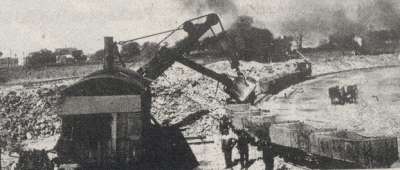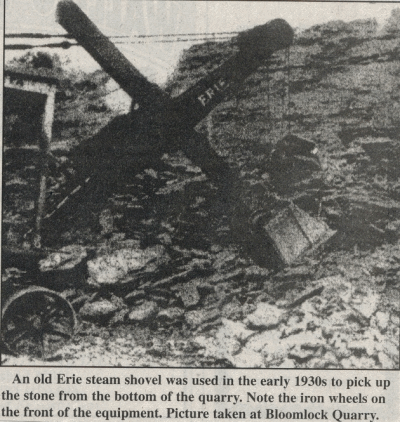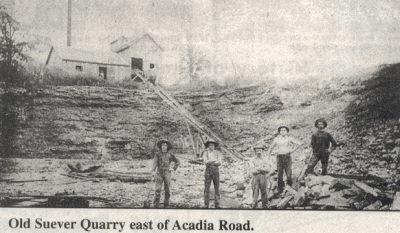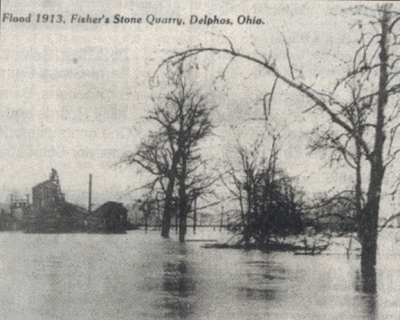
France Stone Quarry Near Middle Point 1910
Window to the Past
The Middle Point Stone Quarry
By ROBERT HOLDGREVE
The France Stone Company started operations at the Middle Point quarry on Aug. 14, 1888, and ceased operations July 1, 1946. They had been in business for 58 years, and in the height of operations employed 60 people.
Between 90 and 100 acres of what some called the big lake, others a fisherman's paradise and many a familiar swimming spot since 1946, was pumped dry in 1957. Reports were circulated all over the area that a new crusher would be placed in the big hole, which would mean big business again for Middle Point.
In 1956, the owner, George W. France of Toledo, decided that the quarry should be pumped dry. The water averaged between 25 and 40 feet deep including a channel which ran through the area. Four Middle Point men, Harry Showalter, Robert Roodes, Allen Brown and Dale Kline, were assigned the huge task of emptying the hole. When they started, it was predicted that one year of continuous pumping would be required to empty the 78-acre quarry. Pumping took place around the clock with one elevating pump which poured out 2,200 gallons a minute and another pumped 1,000 gallons a minute. The job was completed in a little more than 10 months. The only water remaining in the quarry was in a drainage channel. The water pouring from the quarry was dumped into Dog Creek and finally into the Auglaize River. The pumping was good news to farmers along the stream since it made a clean water supply for livestock which grazed along the stream.
When the quarry was shut down in 1946, the quarry had an output of 50 rail cars a day, which was mostly to the railroads for ballast stone, and to the county commissioners for stone roads. The machinery contained in the huge cement-supported structure was removed in 1946-47. When the quarry went dry, workers were surprised at the small amount of debris found in the bottom. Some large bass which had outsmarted fishermen during the years, fell victim to the operation, while others managed to reach the channel which was nearly 25 feet wide and 20 feet deep and extended nearly a mile.
The total France site consisted of nearly 320 acres, divided by the Middle Point Road with the quarry on the north side. The area north of the main quarry was bisected by a double track main line of the former Pennsylvania Railroad and a small four-acre quarry located north of the railroad. When the quarry was in full operation, cars were filled with stone on a three-track siding.
Sometime around 1990, the quarry was considered as a possible site for a "mini-park." The state department's concept of a mini-park was one of about 1,000 acres, providing space for some recreational activities, but not on a scale of a large park of 5,000 acres.
This site has been posted against fishing and other activities by the France Company of Waterville, Ohio, for many years.
The above information was taken from "History of Van Wert County" by Floyd O'daffer.
In 1888, the Pennsylvania Railroad planned to lay a second track alongside the single track. The France Stone Company contracted to supply ballast for the railroad from Fort Wayne to Crestline. This was when they started the Middle Point Quarry.
Around 1914 or 1915, the Middle Point Quarry bought a large steam shovel which was used to help build the Panama Canal.

France Stone Quarry Near Middle Point 1910
Some history of the Delphos Stone Quarry
William and Nathaniel France started the France Stone Company at Toledo.
Willis France bought the old stone quarry, now owned by the Delphos Sportsmen Club, from Aaron Fisher. When the quarry ran out of space to expand, land was purchased from Nicholas Hohenbrink in 1925 at the present site.
Decision in Delphos case is rendered
A decision in favor of E. Harry France has been rendered by the District Court of Appeals in connection with a suit involving the land adjoining the Limestone Quarries company property at the west edge of Delphos.
The land in question was purchased by France Stone Company from Nicholas Hohenbrink and Clem Odum. E. Howard France later brought suit to have the land transferred to him, alleging that he held an option on the land, and that the sale to the France Stone Company was not legal.
A decision in his favor was rendered by Judge Summer Walters in Van Wert County Common Pleas Court. This decision held that the option was valid. The case was carried to the Court of Appeals by the France Stone Company, and the appellate court upheld the decision of the Van Wert court.
From Delphos Herald June 1931
At one time, Delphos Quarries received a contract from the Nickel Plate Railroad to supply 10,000 tons of stone per month for ballast, to build a new rail yard at Bellevue. This was over and above their regular order. The job took one year to complete. They had an electric-operated shovel in the hole at the time, and needed more reliability, so they obtained a shovel from the Middle Point Quarry.
Delphos Quarries bought a new diesel-powered shovel around 1950 or 1951.
Don Imber, who worked at the Delphos Quarry from 1950 to 1981, and is now 91 years old, said that he remembered seeing a fossilized bird in the stone wall of the quarry.
Mrs. Howard Lewis managed the Delphos Quarry for a short time after her husband died. In 1985, Mrs. Lewis, Mrs. Richard Werbe, Mrs. Oscar Foster and Miss Judy France, all nieces of Willis France and owners of the Delphos Quarries, sold the quarry to Carl Suever and Donald and Eileen Lause. They then sold the Delphos Concrete Plant to L.P. (Pete) Vetter of Fort Jennings, who continued to operate the plant at the quarry site. At that time the Delphos Quarries consisted of 74 acres, with 40 acres already mined since the quarry started in 1925.
At the present time, 2002, Glen and Neal Lause own the Delphos Quarries, having purchased it in 1994. For further expansion, more land has been purchased.
History of Bloomlock Quarry near Landeck
Matt Suever, grandfather of Carl Suever, started the first quarry on his farm on Acadia Road in the late 1800's. Albert and Leona Suever, Carl's parents, were the next owners and purchased the Spencer Stone Company in 1931, the present quarry on Bloomlock road.
A slight variation of the same information is found in the Landeck Centennial book.
In Spencer Township, near the present Suever Stone Company, limestone was found to be near the surface and to be of excellent quality for gravel.
A stone quarry was started about 1900 by some Welsh farmers behind the present home of Alloyious Schwinnen. All work had to be done by hand, the dirt had to be scraped off, rocks chipped out and then broken up with sledge hammers.
It was taken under new management a few years later and was organized as the Spencer Stone Company. The hole was worked until around 1928. It is presently full of water, and is approximately 40 feet deep. Matt Suever started his quarry east of the Acadia Road in approximately 1905. This was also around 40 feet deep and was closed in 1931 or 1932.
Carl, his late brothers Robert and Donald, and Eileen Lause were the next owners as of March 1961.
In addition to quarrying regular stone and limestone at their business, and they added the hot and cold asphalt plants at the Bloomlock Quarry.
An old Erie steam shovel, with iron wheels on front, was used to pick up stone from the bottom of the quarry in the 1930's.
Some more land has been purchased across the road for further expansion of the quarry.
All the above information was from: Don Imber, Eileen Suever, Bill Hoverman, Richard Moenter, a "Delphos Herald" article dated Feb. 22, 1985, and the Landeck Centennial Booklet, 1873-1973.



Fisher Stone Quarry
Compiled by Robert Holdgreve
Delphos Historical Society
February 23, 2002